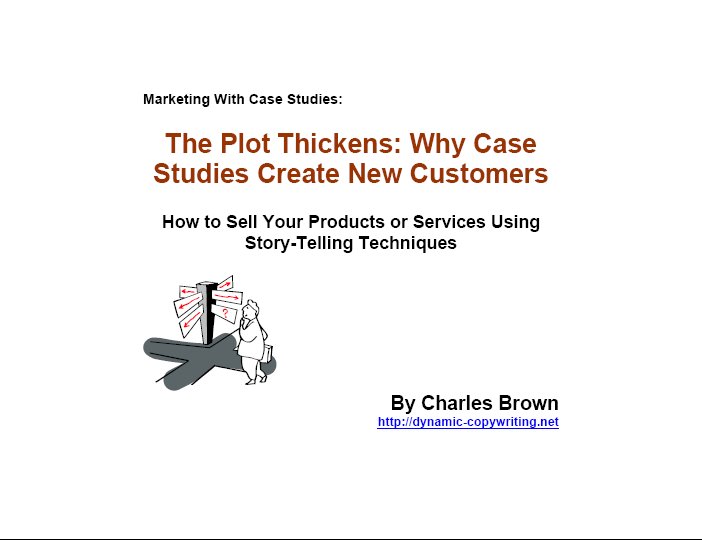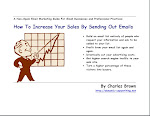Learn The Power of Educational Marketing
0 comments Posted by Charles Brown at Monday, December 29, 2008Whether you sell a product or a service, you will put yourself miles ahead of your competition if you include an education element to your marketing process. This is why white papers, case studies, informative web content and ebooks are such popular and powerful marketing tools these days. It is also why many marketers find themselves in front of audiences giving speeches, seminars or workshops.
The fact is that companies or professionals who take the time to educate and share their knowledge can establish a much higher level of credibility in their customers’ eyes than those who simply go after the sale.
But what about educating customers and clients after the sale?
I found myself thinking about this after reading John Jantsch’s recent article Teach Your Way To Referrals in his blog on Duct Tape Marketing. (By the way, if you aren’t reading Duct Tape Marketing yet, you are missing out on a wealth of great ideas and information).
Jantsch makes the excellent point that after sale education efforts pay off big time in referrals, and I would also add repeat business.
This is simply not that hard to do. I am working with a client right now who has asked me to create an ebook and email marketing campaign for sales people who use his products. Without revealing confidential information, his products help a variety of sales people and small businesses generate leads.
The ebook he wants me to write is going to be a free, downloadable educational product that will give his prospects marketing tips and ideas. And once the ebook is downloaded, the prospect will receive regular emails that offer more tips and advice. (I'm sure you will recognize this as a classic "Permission Marketing" campaign).
Similarly, you can easily find a variety of ways to communicate your own knowledge and expertise to your target market and existing customers. It isn't a difficult process, just identify the problems customers want to solve or questions they ask (or better yet, look for the questions they should be asking but don't yet know enough to ask them). Create simple info products or presentations that address these hot buttons and you have an educational marketing campaign.
Jantsch puts it this way:
I know I love it when I get buy a product and the first thing I receive is a getting started guide, followed by a full tutorial, followed by daily “have you tried this” emails. Every business, product or service can do the same.
Check out his article at Teach Your Way To Referrals, and if you are not already reading his blog, start doing so now. You’ll thank me later.
And one more thing. If you would like to learn more about this educational approach to marketing, be sure to download a free copy of my own ebook, How To Increase Your Sales By Sending Out Emails. You will read about other businesses that have gotten excellent results by educating their customers and prospects.
COPYRIGHT © 2008, Charles Brown
Top Ten Reasons You MUST Put an Opt In Form On Your Site's Home Page
0 comments Posted by Charles Brown at Friday, December 19, 2008The most glaring problem I see on the business (or charitable) websites I visit is the lack of a form, clearly visible on the home page, to encourage visitors to opt in to an email list. The owners of these sites, frankly, are failing to take advantage of one of the best assets for putting up a website at all.
When I give talks to business people, one of the caveats I preach over and over again is that the most important reason to even have a website is to build an email list of qualified, interested prospects who willingly volunteer to receive information from you.
It is NOT enough to put a lame comment like “For more information call 1-800-XXX-XXXX.” Folks, it is not going to happen. They are not going to initiate contact, you have to do it. So give your visitors incentives. Bribe them! Give them self-serving, “what's in it for me” reasons to fill out a little form on your home page that asks for their names and email addresses.
So here are ten, plus one, reasons why your site should have a clearly visible place for your visitors to opt in to receive informative emails from you:
- An opt in form enables you to build a list of people who have an interest in what you offer. Direct marketers have long quoted the mantra, “the money is in the list” for good reason. A list of interested prospects or repeat customers is the most valuable asset any business can have.
- An opt in list allows you to target people who have given you permission to market to them. Read Seth Godin's modern classic, “Permission Marketing : Turning Strangers Into Friends And Friends Into Customers” which introduced the worlds to the concept of getting prospects to opt onto your list by providing free information that solves problems specific to your target market or helps them achieve certain goals that are, again, unique to your targeted prospects.
- The people on you opt in list have self-selected themselves as your target market. This means you will no longer have to use the shotgun approach of trying to advertise or send direct mail to huge numbers of people. Seth Godin calls this getting prospects to “raise their hands” and identify themselves as people have needs your product or service can address.
- The people on your opt in list WANT to receive your messages. As long as you don't bombard them with sales messages and provide them with a lot of useful, helpful information, they will continue to look forward to your emails.
- Since most autoresponders require the person to confirm their request before they receive your information, you avoid accusations of spamming them.
- Speaking of autoresponders, they are a software program available for minimal cost that sends out your emails automatically. The visitor fills out your opt in form, next receives an email that asks them to click a link in order to confirm that they wanted to receive the information, and then they are sent a second email with the requested info. Then they will receive your pre-written emails with additional information at regular intervals. This means your entire marketing program can be put on autopilot by using opt in forms and an autoresponder.
- Sending out emails to the people on your opt in list is free. In an age when advertising and other forms of marketing is simultaneously becoming more expensive and less productive, email marketing to people who have requested your information is a true bargain.
- An opt in form allows you to have repeated contacts with people who would otherwise be one time visitors to your website. Let's face it, a website is like a screen door on a submarine. Most visitors come to your site for about a minute and then leave. Very few people will buy on their first visit to your website. But if you get their attention and give them and incentive to opt in to your list by offering them some very useful information, you can nudge them again and again (again let me repeat that this works best if you continually give them useful information along with your sales and marketing messages), until they buy.
- Continuing this last thought, opt in marketing defeats the hazard of one-shot marketing. Most people will not decide to buy on their first exposure to an offer. They need repeated exposures to absorb all of the benefits you offer and to develop a belief that your claims are true.
- Opt in marketing can position you and your company as experts if done right. Offering free information puts you in a whole different category of people who want their business. Both the initial piece that entices them to opt in, and the ongoing emails that give you additional opportunities to communicate your message to them, show them that you are capable of solving their problems or helping them achieve their goals.
BONUS REASON: Perhaps the best reason of all for having an opt in form on your website is that your list building efforts allow you to build a relationship with your prospects. Over time, you become a known and trusted source and advisor. Because you take time to educate the people on your list, your credibility climbs through the roof. And nothing in business can beat a relationship built on trust and credibility.
COPYRIGHT © 2008, Charles Brown
Mike Santoro over at Duct Tape Marketing, has a neat article about a good marketing idea gone bad.
Apparently Delta bought some Google ads for the keyword “cheap train tickets.” Obviously Delta flies airplanes and is not in the train business, but give them credit for understanding that their competition is not just American Airlines or British Airways. They are competing against every carrier that provides transportation to passengers.
But, as Mike points out, clicking the link leads only to Delta's main home page. The visitors, who thought they had clicked an ad for cheap train tickets, find themselves on an airline's site. Huh? I have no doubt that 100% of these visitors either felt they were deceived or clicked away in confusion.
Mike's article goes on to say that if Delta had simply sent them to a page that offered comparisons of their air fares to train fares on certain routes, they may have converted a good number of these visitors. As it was, they no doubt wasted every penny they spent on these ads.
The lesson is that your home page is not the place to send every visitor. If you go to the trouble of getting links for certain types of visitors, such as through PPC (Pay Per Click) ads, think through what these people want, what they are looking for, and what information they are seeking.
AND give them what they want.
This all goes back to the idea of “Buyer Personas” again. Don't treat all your visitors as if they were all stamped out of the same mold. Every website offers different things to different types of visitors. The better you are at distinguishing the different needs and wants that drive these visitors, the better you will do at turning them into buyers.
This is especially true if you use PPC ads such as Google Adwords. Delta's visitors clicked links about cheap train fares. When they arrived at Delta's site, they had questions about cheap train fares and expected answers, which Delta failed to deliver.
Check out Mike's article at Delta Screws Up Smart Google Ad Buy. I think you will find it helpful.
COPYRIGHT © 2008, Charles Brown Add to Onlywire
Labels: buyer personas, Google ads, PPC, writing website content
Recently as I've consulted with a number of business owners about writing content for their websites, I've once again been struck once again how difficult it is for most of them to come up with a “Unique Selling Proposition,” or USP, for their business.
A USP is an essential focused statement that tells a prospective customer or client why they would benefit from doing business with you. It is the “REASON WHY” buying they should buy your product or engaging your service.
What normally happens is business owners tell the world about themselves or their companies or their products. What we normally see is a “tell, tell” approach.
Look at magazine ads or Yellow Page ads for examples of what NOT to do. Most of these ads will not show you a real USP. You will see a lot of bragging or unsupported claims like, “we deliver excellence.”
I had an English teacher that referred to this kind of writing as “Solemn Vapors” because they use a lot of high sounding wording. Think of essays turned in by freshman English students and you will know what I mean.
So how do you write a succinct USP? How do you communicate what you do in a way that will persuade a potential customer to do business with you? Here are some ideas to help you create a powerful USP.
- What CHANGES are your potential customers or clients seeking? How can help them bridge the gap between where they are now and where they want to be? Most people buy to bring about some sort of change. This change can be to make their lives easier or more comfortable. To give them more status or pleasure, or it can be to make their work easier or faster.
The point is that if you focus on changes, you get your eyes off yourself, your company and your product. You stop talking about things like how long you've been in business or how respected you are in the community. - Make sure you discuss these changes with specifics. Don't use change substitute words like “Results” or “Difference.” Make a clear distinction between the “Before” situation your prospects live in now, and the “After” situation they want to be in.
- Focus on problems. Most really good USPs are about solving, avoiding or escaping a problem situation. Even the classic M & M candy commercial talked about candy that melted in your mouth not in your hands. That slogan was a great USP that dealt with a problem every parent has encountered, chocolate covered hands on a little toddler.
If you can solve a business problem, help someone get out of debt, make more money, help a teenager get rid of acne, save a marriage, or solve any other kind of problem, you can turn this problem – solution scenario into a great USP. - Brag about quality. Ok this is the really dangerous one. Most claims of quality are empty and vague. But if you can do more than make a generalized claim of excellence and give specifics about how you achieve this quality, you can use quality as your USP. For example, if you use only the very best materials to make your products, or you have instituted a quality control process that is unique in your industry, these might be worth bragging about. If you put your service people through twice as much training as your competitors, or if you are the owner of an auto repair shop who actually telephones each and every customer after a visit to make sure they were satisfied with the service they received, you can brag about these things as well.
Make sure any claim to quality can be backed up with specifics.
A good USP will stand out in the market place and will give your customers a reason to seek you out and buy from you.COPYRIGHT © 2008, Charles Brown
Labels: USP, writing website content


